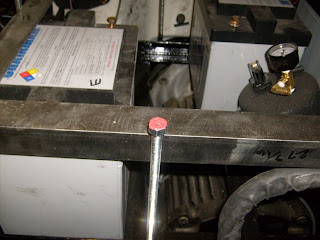Today I worked on the hold-down for the front battery rack. First, I cut 1 1/2" by 3/16" angle stock to size and welded it together (it's basically identical to the dimensions of the base of the front rack):

Next, I test-fit it over some batteries in the front rack. I think I knew this was going to happen, but I had managed to forget about it - the hold-down interferes with a lip projecting from the firewall:

Here is the area of interference outlined with a Sharpie:

I'm not sure how structural this part is. But, just in case, rather than removing it, I just cut it a little and bent it up out of the way - the bent part should still provide some vertical stiffness:

As you can see, the hold-down no longer interferes with the firewall protrusion:

So, here is the hold-down in place. There is still a fair amount left to do - I need to put the crosspieces on, and I need to add the flanges where the bolts will clamp down on the 3/8" rod. Also, I need to cut two outlet holes in the front of this hold-down to allow the 4/0 welding cable to come in/out of the rack.

With the hold-down in place, I can now shorten the 3/8-16 rod. I left it 1/2" longer than the top of the hold-down (to account for 1/4" of polypropylene and 1/4" of threads for the nut to grip). And now, the true acid test - closing the hood. Unfortunately, it failed. So, I borrowed one of my daughters' lipsticks and marked the rod/nuts:

Here is where that touched the hood. I circled it on the left and right with a Sharpie to make it easier to see:

And here are the holes I drilled out so the hood can close:

With all that, here is the closed hood with the top in place:

Thinking back on it, I suspect what happened with my previous test was that I assumed that the outside corner was the most likely interference point. I did not think of the rod sticking up...





































